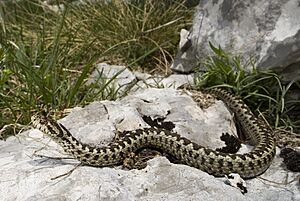Vipera ursinii facts for kids
The meadow viper (Vipera ursinii) is a special kind of snake that lives in meadows and grassy areas. It is a venomous snake, but it is usually shy and tries to avoid people. This snake is very rare and is in danger of disappearing forever. You can find it in parts of Europe and as far east as China. It is also known by names like Ursini's viper or meadow adder.
Quick facts for kids Vipera ursinii |
|
|---|---|
 |
|
| Conservation status | |
| Scientific classification | |
| Genus: |
Vipera
|
| Species: |
ursinii
|
| Synonyms | |
|
|
Contents
Where Did Its Name Come From?
The meadow viper's scientific name, ursinii, honors an Italian naturalist named Antonio Orsini. He was a scientist who studied nature.
What Does the Meadow Viper Look Like?
Adult meadow vipers are usually about 40 to 50 centimeters (16 to 20 inches) long. Some have been found to be as long as 63 to 80 centimeters (25 to 31 inches). Female snakes are usually bigger than males.
This viper is the smallest one in Europe. It has a thick body and a narrow head. The tip of its nose does not point upwards. On top of its head, it always has several large scales. Its back scales have a ridge down the middle, making them look rough. These scales are in 19 rows, and you can often see dark skin between them. The snake's color can be gray, tan, or yellowish. It has a dark wavy stripe down its back, which is outlined in black.
Where Do Meadow Vipers Live?
Meadow vipers live in many places across Europe and Asia. You can find them in southeastern France, Hungary, central Italy, and countries in the Balkans like Serbia and Croatia. They also live in Romania, Bulgaria, Greece, and Turkey. Further east, they are found in Armenia, Georgia, Russia, and across the steppes of Kazakhstan, Kyrgyzstan, and Uzbekistan. They even live as far as northwestern China (Xinjiang).
A specific type, Vipera ursinii rakosiensis, is originally from Hungary. However, scientists are still debating if it should be considered a separate subspecies.
Why Are Meadow Vipers Endangered?
The meadow viper is considered a Vulnerable species by the IUCN Red List of Threatened Species. This means it is at high risk of becoming extinct in the wild. There are several reasons why this snake is in danger:
- Habitat Loss: Changes in farming methods and climate change in mountain areas are destroying the places where these snakes live.
- Collection for Pets: Some people illegally collect these snakes to keep as pets, which reduces their numbers in the wild.
To protect them, the meadow viper is listed on CITES Appendix I. This means it is illegal to trade them internationally for commercial purposes. It is also a strictly protected species under the Berne Convention.
The meadow viper is the most threatened snake in Europe. Many human activities put these animals at risk:
- Grazing animals eating their habitat
- Mowing grass where they live
- Fires, both natural and human-caused
- General agriculture and farming
- Building roads and other constructions
- Leisure activities like hiking or off-roading
- Planting forests where grasslands used to be
- Hunting management that affects their prey or habitat
- People harming them on purpose
- Illegal collection for the pet trade
- Littering, which can harm them or their food sources
How Scientists Study Meadow Vipers
Scientists are still learning about the meadow viper. There is a lot of genetic diversity among these snakes, meaning there are many different types. Some scientists believe there might be several different species, not just one.
In older books, you might see different types listed as subspecies, like:
- Vipera ursinii ursinii
- Vipera ursinii eriwanensis
- Vipera ursinii graeca
- Vipera ursinii macrops
- Vipera ursinii moldavica
- Vipera ursinii rakosiensis
- Vipera ursinii renardi
However, not all scientists agree on how many subspecies there are, or if some of these should be considered full species. More research is needed to fully understand the meadow viper family tree.


